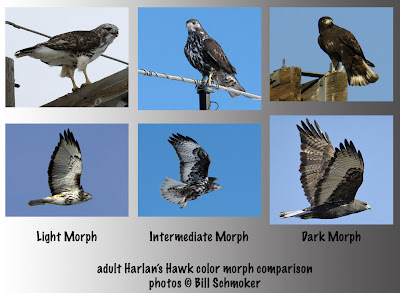 I found another interesting Red-tailed Hawk last weekend at Cherry Creek State Park in the SE Denver Metroplex. At first glance it had some Rough-legged Hawk traits, particularly the look of a black belly band with dark breast streaking above and lots of white on the head. Getting it scoped, however, quickly dispelled that ID- the bare legs, for example, immediately rule out Rough-legged. I recognized the bird as a Red-tailed Hawk, and suspected it was a Harlan's Hawk (the harlani subspecies that breeds mostly in Alaska and the Yukon.)
I found another interesting Red-tailed Hawk last weekend at Cherry Creek State Park in the SE Denver Metroplex. At first glance it had some Rough-legged Hawk traits, particularly the look of a black belly band with dark breast streaking above and lots of white on the head. Getting it scoped, however, quickly dispelled that ID- the bare legs, for example, immediately rule out Rough-legged. I recognized the bird as a Red-tailed Hawk, and suspected it was a Harlan's Hawk (the harlani subspecies that breeds mostly in Alaska and the Yukon.) The undertail coverts and leg feathering were pretty rufous, and the distal half or so of the tail was pretty reddish, but the base of the tail had the classic mottled gray color of a Harlan's. Also, the belly and breast streaking were blackish, not dark brown of other Red-tails. The goggled look, big-looking eyes and relatively smaller bill, vertical white/black streaking of the breast, and near lack of pale highlights in the scapulars all pointed to Harlan's Hawk as well. Just to be sure, I consulted with some of my pro raptor-id buddies and they agreed that the
 bird is an intermediate-morph Harlan's Hawk. It seems like some distant calurus (the western Red-tailed subspecies) influence may be present, but then again maybe not- this topic seems tricky and may not be resolvable without DNA analysis. The main thing that seems to confuse people is that Harlan's Hawks can have red in their tails- they just can't have predominantly red tails like adults of most other RT subspecies. I've been birding with folks who immediately write-off a potential Harlan's Hawk because of this, but both Brian Wheeler and Jerry Liguori discuss the eminent possibility of red in Harlan's Hawk tails in their excellent raptor ID books (and in personal email exchanges.)
bird is an intermediate-morph Harlan's Hawk. It seems like some distant calurus (the western Red-tailed subspecies) influence may be present, but then again maybe not- this topic seems tricky and may not be resolvable without DNA analysis. The main thing that seems to confuse people is that Harlan's Hawks can have red in their tails- they just can't have predominantly red tails like adults of most other RT subspecies. I've been birding with folks who immediately write-off a potential Harlan's Hawk because of this, but both Brian Wheeler and Jerry Liguori discuss the eminent possibility of red in Harlan's Hawk tails in their excellent raptor ID books (and in personal email exchanges.) I'm noticing that if a Harlan's Hawk has red in its tail, it is often more extensive in the outer tail feathers, with the gray going farther out in the middle feathers. (By the way, in any RT subspecies the red is mostly on the top of the tail, not the bottom, so from underneath you won't always see it- the bird in this post shows both the underside and top of the tail for comparison. To get the tail lit up red from underneath, the bird usually needs strong light coming from above- see this bird as an example.) I thought I'd cobble together a little comparative matrix, showing adult light-, intermediate-, and dark-morph Harlan's Hawks perched and in flight. There is essentially an unbroken continuum between the light-morphs and dark-morphs, but I've tried to choose good matches for the end members and a pretty middling intermediate bird. Birds that are more darkish-light, light-intermediate and dark-intermediate, and lightish-dark are out there, too, but I'm not including them in this comparison. You'll note that good, dark Harlan's still have at least a wee bit of white streaking on the breast, something that calurus dark-morphs lack. Also note the cold, blackish steaks on even the light-morph individual, not brownish like on light morphs of other RT subspecies. Maybe I'll do a similar matrix sometime for juveniles, but they largely follow the pattern, differing mainly in eye color and tail pattern.









No comments:
Post a Comment